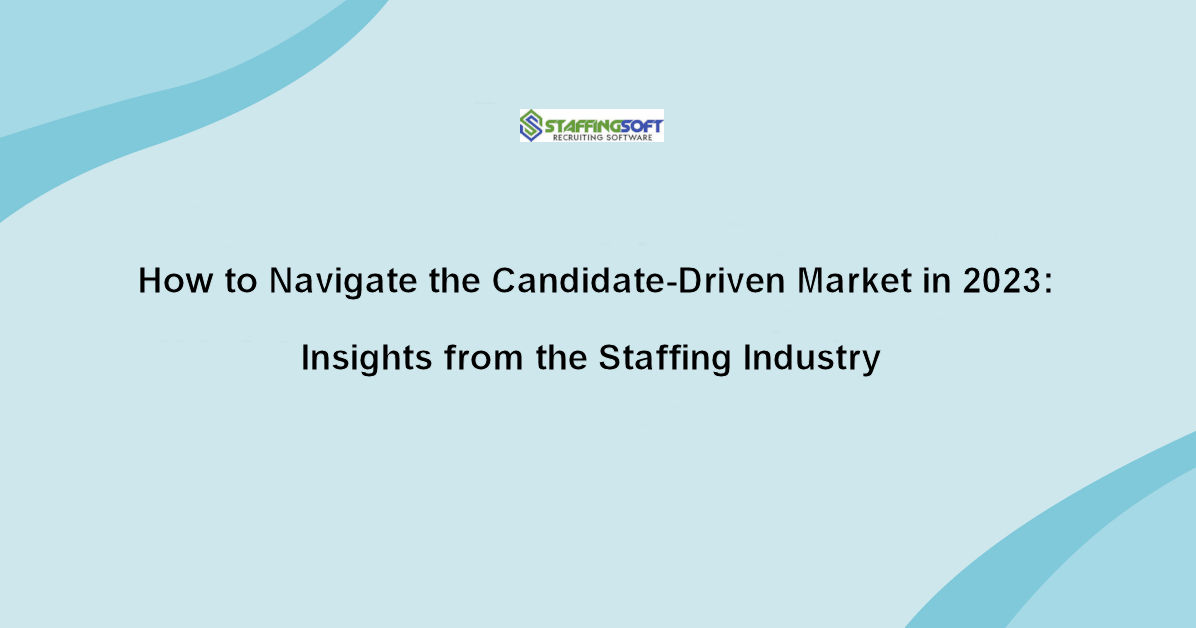In the ever-evolving world of recruitment, the job market continues to be influenced by various factors. As we halfway into 2023, one of the key challenges faced by employers is the candidate-driven market. In this scenario, job seekers have the upper hand, and organizations need to adapt their hiring strategies to attract and retain top talent.
In this blog post, we will explore some valuable insights from the staffing industry to help you successfully navigate the candidate-driven market in 2023.
-
Understanding the Candidate-Driven Market
In a candidate-driven market, job seekers hold the advantage. With a low unemployment rate and increased demand for specialized skills, candidates can afford to be more selective about the opportunities they pursue. To effectively navigate this landscape, it is essential to understand the motivations and expectations of candidates.
-
Recognize the Power Shift
In a candidate-driven market, the power dynamics have shifted. Candidates are in high demand, and organizations must go the extra mile to attract and retain top talent. Recognizing this shift is the first step in developing effective strategies to navigate the market successfully.
-
Adapt to Changing Expectations
Candidates in 2023 have different expectations compared to previous years. They seek more than just a paycheck; they value company culture, work-life balance, career growth opportunities, and flexibility. Organizations need to align their employer branding and recruitment strategies with these changing expectations to stand out from the competition.

-
-
Building an Employer Brand
In a candidate-driven market, attracting top talent requires a strong and compelling employer brand. Job seekers are looking for organizations that align with their values, offer growth opportunities, and foster a positive work culture. To build a powerful employer brand:
-
Define your unique value proposition:
Identify and communicate what sets your organization apart from others. Highlight your company’s mission, culture, benefits, and career development opportunities.
-
Enhance your online presence:
Leverage digital platforms to showcase your employer brand. Optimize your company website, social media profiles, and online review platforms to create a positive image of your organization.
-
Foster employee advocacy:
Encourage your employees to share their positive experiences and stories on social media. Employee testimonials can be a powerful tool to attract top talent.
-
-
Streamlining the Recruitment Process
To thrive in a candidate-driven market, it is essential to streamline your recruitment process to minimize delays and ensure a positive candidate experience. Some strategies to consider include:
-
Optimize job descriptions:
Craft clear, concise, and engaging job descriptions that highlight the role’s impact and the organization’s culture. Use inclusive language and focus on the value proposition to attract a diverse pool of candidates.
-
Accelerate the hiring process:
Reduce time-to-hire by eliminating bottlenecks and unnecessary steps. Leverage technology such as applicant tracking systems, video interviews, and skill assessments to streamline the process without compromising quality.
-
Personalize candidate interactions:
Treat candidates as individuals and provide timely updates throughout the hiring process. Engage in personalized communication to demonstrate your interest in their candidacy.

-
-
Embracing a Candidate-Centric Approach
In a candidate-driven market, organizations need to adopt a candidate-centric approach to stand out from the competition. Here are some ways to prioritize the candidate experience:
-
Transparent communication:
Maintain open lines of communication with candidates, providing clear expectations and updates on their application status. Even if they are not selected, give constructive feedback to help them improve.
-
Flexible work arrangements:
Embrace remote work options, flexible hours, and other work-life balance initiatives to attract top talent who value flexibility.
-
Professional development opportunities:
Highlight the growth potential within your organization. Showcase training programs, mentorship opportunities, and ongoing professional development to attract ambitious candidates.
-
-
Leveraging Technology and Data
In the digital age, technology plays a pivotal role in the recruitment process. To gain a competitive edge, organizations should leverage technology and data analytics:
-
Applicant tracking systems (ATS):
Utilize ATS to manage the recruitment pipeline, automate processes, and track candidate interactions. This will improve efficiency and help you identify areas for improvement.
-
Talent analytics:
Leverage data analytics to gain insights into your recruitment metrics. Analyze data on sourcing channels, time-to-hire, candidate drop-off rates, and the effectiveness of your employer branding efforts to make data-driven decisions.
-
AI-powered solutions:
Explore the potential of AI-powered tools such as chatbots for initial candidate screening, video interviewing platforms, and algorithms that match candidates with suitable roles.
-
Conclusion
As we navigate the candidate-driven market in 2023, organizations must adapt their hiring strategies to attract and retain top talent. By building a strong employer brand, streamlining the recruitment process, adopting a candidate-centric approach, and leveraging technology and data, companies can position themselves as desirable employers and successfully compete in the evolving job market.
Embracing these insights from the staffing industry will enable organizations to navigate the challenges posed by the candidate-driven market and secure the best candidates for their teams.




